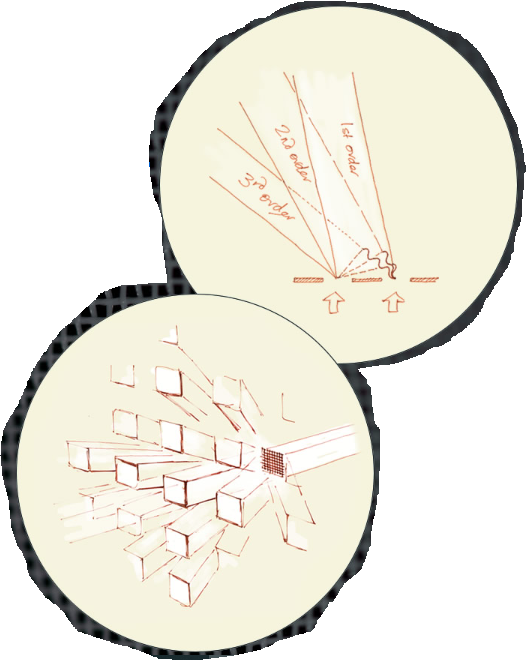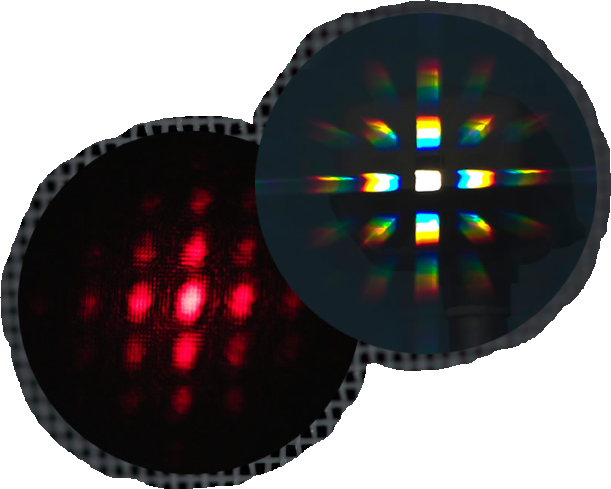Diffraction through a mesh curtain - OPOD
Diffraction through a Mesh Curtain: Unveiling the Secrets of Light
Have you ever looked at a seemingly ordinary mesh curtain and been captivated by the magical play of colors and patterns it creates? Well, you're not alone. Graham Finney, an avid observer of atmospheric optics phenomena, decided to explore the wonders of diffraction by peering through his mesh curtain. The results were nothing short of astonishing.
When sunlight hits a glint on the curtain, it illuminates a small area that is surrounded by a mesmerizing square array of spectra. These spectra become more vibrant and spread out as they move away from the glint. But how does this happen? The answer lies in the intricate workings of diffraction.
A mesh curtain, with its fine array of holes, acts as a diffraction grating. Each hole becomes a source of light that emits spherical waves. As these waves interact with waves from neighboring holes, they create interference patterns. In certain directions, the overlapping wave crests align perfectly, resulting in brightness at specific angles. However, this phenomenon is not uniform across all wavelengths. White light, for instance, splits into its constituent colors, forming a beautiful spectrum.
The mesh curtain, being a one-dimensional grating, produces multiple directions where the waves from the holes overlap in-phase. These overlapping patterns occur at increasing angles from the incoming beam. As we move to higher orders, the sensitivity to wavelength increases, causing the spectrum to spread wider. This explains why the glints from the street lamp in Graham Finney's images displayed widely spread colors.
But what if we had a two-dimensional grating like the mesh curtain? In such cases, we would observe a square array of spectral orders. This intricate interplay between light and the mesh curtain reveals the underlying complexity of diffraction patterns. In fact, three-dimensional gratings like crystals can produce even more intricate diffraction patterns that unveil the crystal's unique structure.
To capture the diffraction pattern created by the mesh curtain, it is essential to use a telephoto lens from a distance. Unless the mesh is incredibly tiny, the resulting pattern will be small and require magnification for a detailed observation.
While the images captured by Graham Finney showcased the beauty of diffraction through sunlight, what happens when we use a laser beam? Interestingly, the laser beam produces monochromatic spots without any spectra. This phenomenon further highlights the wavelength-dependent nature of diffraction and its ability to transform light into intricate patterns.
In conclusion, diffraction through a mesh curtain is a captivating spectacle that unravels the mysterious behavior of light. The interplay between spherical waves emitted from the holes and their interference patterns leads to stunning displays of color and pattern. Whether it's a simple mesh curtain or complex three-dimensional gratings, the world of diffraction never fails to amaze us with its intricate beauty. So next time you come across a mesh curtain, take a moment to appreciate the hidden secrets that lie within its folds.

Peeping through curtains
Part of an innocent and unlit street light glints sunlight towards the camera. Graham Finney imaged it directly and then through his mesh curtain. The result - surprises.
Images ©Graham Finney
The bright glint is surrounded by a square array of spectra. Their colours spread more and more with distance from the glint.
The mesh curtain - page background - acts as a diffraction grating.
Light leaving each hole spreads out in spherical waves. These interact with those from nearby holes. In certain directions the overlapping wave crests are in phase and there is brightness at that angle. The condition is wavelength dependent and so with white light is split into colours and a spectrum is produced.

There are many directions where waves from the holes of a 1-dimensional grating overlap in-phase.
The higher order overlaps are at increasing angles from the incoming beam.
Higher orders are more sensitive to wavelength and spread the spectrum wider.
The higher order glints from the street lamp above have widely spread colours.
A 2-dimensional grating like the mesh curtain produces a square array of spectral orders.
3-dimensional gratings like crystals produce complex diffraction patterns that can be unravelled to reveal the crystal's structure.
Diffraction by the mesh enlarged.
Unless the mesh is tiny, the diffraction pattern is small and needs to be imaged from a distance with a telephoto lens.

Graham Finney imaged the diffraction by the mesh of a laser beam. No spectra, monochromatic spots.
Note: this article has been automatically converted from the old site and may not appear as intended. You can find the original article here.
Reference Atmospheric Optics
If you use any of the definitions, information, or data presented on Atmospheric Optics, please copy the link or reference below to properly credit us as the reference source. Thank you!
-
<a href="https://atoptics.co.uk/blog/diffraction-through-a-mesh-curtain-opod/">Diffraction through a mesh curtain - OPOD</a>
-
"Diffraction through a mesh curtain - OPOD". Atmospheric Optics. Accessed on December 22, 2024. https://atoptics.co.uk/blog/diffraction-through-a-mesh-curtain-opod/.
-
"Diffraction through a mesh curtain - OPOD". Atmospheric Optics, https://atoptics.co.uk/blog/diffraction-through-a-mesh-curtain-opod/. Accessed 22 December, 2024
-
Diffraction through a mesh curtain - OPOD. Atmospheric Optics. Retrieved from https://atoptics.co.uk/blog/diffraction-through-a-mesh-curtain-opod/.